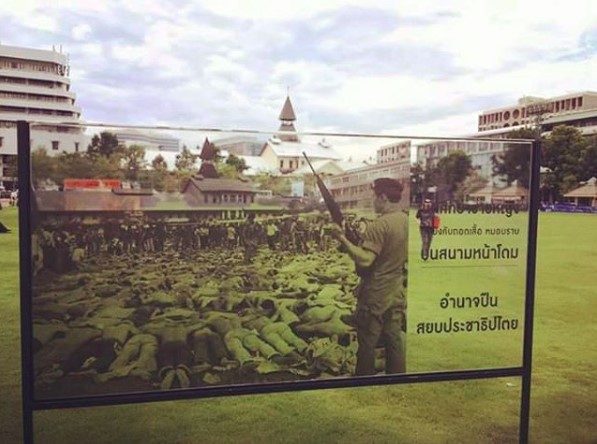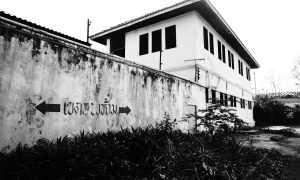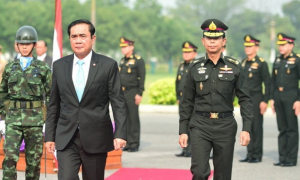It is not the number of the deceased (40) that has made the massacre of students at Thammasat University on 6 October 1976 linger in the memories of no small number of people, so much as images showing the unthinkably savage actions committed against the victims. But we would be mistaken to think that it was only those most repulsive actions that led to the deaths of people that day.
From careful study of the available evidence, we have found only one person who lost their life due to mob vigilante violence or torture. Instead, bodies were often brutally treated after the victims had already died. Several victims lost their lives from bullets or explosions, but their bodies continued to be assailed long after the life had left them. The images of 6 October that have circulated in the aftermath are then images of crowds egging each other on to desecrate the deceased.
That knowledge may provide us some small comfort that the victims did not have to endure such intense torture while alive, but it also raises formidable questions. Why did people feel compelled to treat the bodies of the deceased so savagely—in public before thousands of eyes, in front of state officials and in the company of hundreds of both Thai and international journalists? How are we to understand the public desecration of corpses in Thai society?
The available evidence
People engaged in the following cruelties on the morning of 6 October:
- Hanging people and taking turns to strike and kick the bodies, using knives to wound the bodies, using planks of wood and chairs to repeatedly beat the bodies, stuffing shoes into the mouths of those who were hung (we know of five people who were hung)
- Pulling bodies along the ground by cloth tied around their necks, or by the legs of their trousers
- Hammering wood into the chests of the deceased
- Piling and setting fire to four bodies, to the point it was impossible to determine the sexes of the deceased
- Urinating on unmoving bodies
- Undressing the body of a deceased young woman and placing pieces of wood on top of her body in a sexually suggestive arrangement (more on this below).
We have been able to determine some details about some of the individual victims of 6 October, including names, the causes of their deaths, and the maltreatment their bodies subsequently faced. We compiled this information from a large collection of photos and videos taken that morning, as well as medical, police and hospital autopsy reports.
1. Wichitchai Amornkul (second-year student at the Faculty of Political Science, Chulalongkorn University)
- Wichitchai was 1 of 5 people lynched at Sanam Luang.
- The autopsy revealed Wichitchai died from being struck with a heavy object and from being choked
- Photographs that show Wichitchai’s tongue sticking out from his mouth suggest that he was likely hung before his death. In any case, several photographs and the autopsy report indicates that crowds continued to mistreat his body even after life had left it. Crowds gathered to strike and kick him, beat him with a chair, and stuff a shoe in his mouth.
- His shirt was removed and sharp objects were used to slice both the front and back of his body. Wounds etched his face and all over his body. More photos are available here.

Wichitchai Amornkul
2. Preecha Sae Eia (journalist–translator, magazine editor)
- Preecha was 1 of 5 people lynched in Sanam Luang.
- Photos show that Preecha was pulled from his car and encircled and attacked by a crowd while he was still alive. He was dragged along a footpath and eventually hung. However, the autopsy reported the immediate cause of his death was a bullet.
- Photos show Preecha’s body continued to be mistreated even after his death

Preecha Sae Eia
3. Kamon Kaewkraithai (17 years old, worked selling newspapers)
- Kamon was 1 of 5 people lynched at Sanam Luang.
- The autopsy report revealed that Kamon died from “shrapnel from an explosion”. Photos and videos show that Kamon died near the Thammasat Grand Hall, before his body was dragged to and hung at Sanam Luang.

Kamon Kaewkraithai

Kamon Kaewkraithai being dragged from Thammasat to Sanam Luang
4-5. Two unidentified males who were hung
- Photos of two males who were hung in front of Thammasat were taken by Neil Ulevich, a photographer for AP Press. Both photos and videos show lifeless bodies, which were nevertheless attacked by crowds.

The first unidentified male. This photo, taken by Neil Ulevich, won a Pulitzer Prize in 1977.

The second unidentified male.
6. Watchari Petchsun (third-year student at the Faculty of Science, Ramkhamhaeng University)
- The autopsy report revealed that Watchari died from three bullets entering from the back.
- The body of Watchari was undressed and planks of wood were placed on her body, pointing to her genitalia. It is possible that her body was sexually violated after her death, though the autopsy did not mention traces of such actions. More details can be found here and here.

Watchari Petchsun
7. Charupong Thongsin
- The autopsy revealed that Charupong died from bullet wounds.
- Crowds wrapped cloth around his neck to pull his body to the Thammasat football field.

Charupong Thongsin being dragged
8. An unidentified male
- An image from a foreign media outlet show a male lying motionless on the ground, while a boy urinates on his body. The identity of the male is not clear.

9. An unidentified male
- The body of a male was dragged by the legs of his trousers in the Thammasat football field, while another male followed beating the body with a piece of wood.

10. An unidentified male
- A photo shows a male using a brick to hammer a long piece of wood into one of 5–6 dead bodies arranged closely.
- The identities of the bodies are not clear. Nor is it clear whether the bodies are any of the other people described in this article. It is also unclear whether all the bodies in the photo had wood hammered into them.

11. Four unidentified individuals
- Images and videos show that the four individuals were likely already dead before they were set on fire in the middle of a road near the Shrine of Mae Thorani.
- Videos show crowds exclaiming “chai yo” (can be roughly translated as “bravo”) and cheering around the pile of corpses. Some people stomped on the corpses as they were set on fire.

Four burnt bodies

Four burnt bodies
From the details above, we can see that Wichitchai Amornkul was the only person who died from physical abuse, though afterwards his body continued to be mistreated. The majority of the deceased appear to have died from bullet or explosion wounds, after which their bodies became the focus of various forms of desecration.
Nobody has ever made the abuse of corpses on 6 October the subject of inquiry. In this article, we will consider the events of that day from two related but different perspectives: the desecration of corpses, and public punishment. At this time, we are not yet able to explain these phenomena fully and satisfactorily. All the same, we hope this initial study will help to stimulate interest in the subject that will lead to further investigations.
The desecration of corpses in Thai law
The desecration or abuse of corpses has long been a pariah action in all societies and all religions. In general, people respect the deceased and hope for them to pass into the afterlife or be reborn with dignity. Necrophilia is viewed as a particularly foul act and many societies—though not all—from ancient times to the present, installed laws to punish the mistreatment and sexual violation of corpses.
But these laws themselves embodied a perennial dilemma: if the deceased are evil people, savage criminals, or committers of treason, lese majeste or blasphemy, are their corpses also deserving of respect and dignified treatment? Almost all pre-modern societies reserved particularly cruel punishment for committers of such crimes, who were subject to heinous penalties quite apart from the usual criminal. Their corpses were regularly discarded, desecrated and made the subject of vandalism and vicious acts, often in public settings.
In contemporary times, legislation across different countries is varied when it comes to corpses. Though many countries do have laws of some kind protecting corpses, others, and at least 10 states in the United States, have not produced clear laws regarding the treatment of corpses. Even when it comes to those countries which do have laws in place, there is no universal standard; the interpretation of crimes when it comes to corpses and the specification of punishment are extremely inconsistent. The differences begin from the basic question of defining the legal status of a corpse—after all, a corpse does not have life, strictly speaking, but nor does it seem appropriate to simply treat a corpse as ordinary property.
When it comes to Thailand, Ajarn Sawatree Suksri from Thammasat University’s Faculty of Law advises that prior to legal amendments in 2015, the Criminal Code did not directly speak of a category of crimes related to corpses. Prior to 2015, if anybody was accused of mistreating a corpse, pursuing punishment or compensation would have required interpreting whether the corpse was “property”. On this matter, there are several possible lines of interpretation: the existence of property requires an owner, an intention to possess, or a price of some kind. Some people argue that a corpse which has living family can be called property—but not a corpse which is survived by no relatives. Under such reasoning, anybody could have done anything to such a corpse prior to 2015—whether violent acts, necrophilia, or other obscene acts—without fear of breaching the law.
A spate of incidents eventually led to the inclusion of a category of crimes involving corpses in the Criminal Code covering several actions ranging from necrophilia, actions leading to the disappearance of a corpse, to slandering a corpse. Some crimes involving a corpse now involve more severe punishment than the same actions involving living people. Regarding slander, for example, law drafters reasoned their intention was to “protect the good morality of the people and public” (it is not the protection of the corpse or the deceased’s family that justifies the more severe punishment). Still, the amendments to the Criminal Code show that lawmakers in contemporary Thailand view the desecration of corpses as something abnormal and to be condemned.
Yet the desecration of corpses as described in law refers to the actions of individuals towards corpses that are generally performed furtively and in secret. But the desecration of corpses on 6 October involved large groups of people, and was performed in a public setting in the middle of the city in the view of thousands of people. The desecration of corpses that day does not fit within the concerns of the Criminal Code. The events that took place on 6 October are perhaps more akin to those social phenomena we group under “mob justice”.
Public punishment as a ritual
There have been few studies of public punishment in the context of Thai society. Perhaps we believe that public punishment is abnormal or exceptional. The public punishments that were levied on 6 October compels us to ask: were they deviant events that suddenly took place with neither cause nor rhyme and reason? Or did the events follow a model or example already familiar to Thai people—whereby various circumstances and factors culminated and matured on 6 October so that the knowledge buried in the consciousness of the perpetrators erupted, and once more guided their hands? If it is the latter, this means that we have overlooked the models and precedents for public punishment in Thai society.
Broadly, studies on public punishment in other countries—for example, the lynching of thousands of black citizens before crowds between 1880 to 1940 in the United States—offer two primary explanations for the phenomenon. The first explanation posits that the actions of white Americans against black Americans took place in a context where white Americans were faced with the destablising of the racist social order. Lynching was a collective reaction that aimed to reinforce a social order that divided along skin colour. Lynching had the character of a collective “ritual” oriented towards maintaining the status quo.
The second explanation has emerged in contexts where a marginalised group in society is excluded from legal protections and access to recourse in the judicial system. As such, they are forced to take justice into their own hands. Here, the pursuit of criminals through public lynching is another form of ritual, with carnivalesque characteristics. The ritual is not a pursuit of collective revenge, however, so much as a moment of collective expression by a segment of society whose voices have hitherto been ignored and excluded—a demand for justice and legal representation, as well as the imparting of a message that they are nevertheless poised to seize justice for themselves in the event of continued exclusion.
The public punishments of 6 October do not fit perfectly within either of these two explanations. Still, though 6 October was not about skin colour, the first explanation may help us understand the punishments that took place that day. The student movement and other victims were accused of threatening and violating the most fundamental tenets of the social order, of wanting to overthrow the nation’s central institution, and of wanting to turn Thailand into a Communist country. Right-wing groups and other citizens who involved themselves in the atrocities feared challenges to the status quo, and resolved to decisively abort the threat.
Almost all cases of public punishment have a ritualistic character, whereby the punishment is a communal performance implicitly guided by certain norms. In other words, the punishment communicates a specific meaning that is legible to members of the society in which the act takes place.
Rituals are characterised by the following traits. First, they follow social conventions governing the meanings of specific actions. Second, there is a message or a meaning to the performance which the perpetrators acknowledge. Third, those participating already possess the knowledge required to play out their roles in the performance. Fourth, there are general standards governing what the performance will involve—the parts of the performance that can be altered or improvised, and the parts of the performance that must be adhered to strictly.
How then could there have been a model for the perpetrators of 6 October to follow? The event appears as the eruption of vengeful emotions that nobody could have anticipated, an extreme event with no precursor but in which the atmosphere and the circumstances in the moment triggered a sudden outbreak of atrocities. The extremities that took place on 6 October may appear far from ritualistic.
But as we argue below, all the cruelties committed that day were united by certain shared characteristics and collectively communicated a coherent message. Moreover, the perpetrators had learnt the conventions for communicating that message from past events. That morning, it did not matter whether the victims were really criminals or only scape goats—what mattered was that the victims performed their assigned roles in the performance of public punishment. The victims were denied their status as individuals and were made to embody the evil feared by the perpetrators.
Public punishment generally has a goal of instruction; such cruelties communicate some meaning. Extreme and violent methods of punishment impart the message that the victims are devoid of value, mirroring the abnormal evilness of the criminals or their exceptionally disdainful acts. In a similar way, the abuse of corpses obliterates the inviolability of the deceased which societies generally uphold. Perpetrators choose their actions carefully, in order to deny their victims the interactions of a civilised society. The message is that their victims are not people. The intent is to utterly destroy their humanity.
Modern day models of punishment via laws and judicial systems do not offer expression for the force of such disdain. The methods are too gentle and offer too much respect to the dignity of the criminal. Not even the death penalty under contemporary penal systems are able to destroy the humanity of criminals so completely.
Public torture and corpse desecration are methods for announcing—loudly, clearly, directly—that the social order onto which the perpetrators hold remains potent. Communicating such a message requires actions that are unequivocal and without vagueness. Perpetrators choose the cruelest possible actions to preserve and reinforce the social order and the foundational beliefs which underpin it. Even when the acts themselves are finished, memories and images communicated through photos and video will continue to proliferate the message for decades to come. The irony of course is that such extremities inevitably betray that the actions and beliefs of the victims had indeed begun to shake the social order to its core.
The meanings and origins of corpse desecration on 6 October
If 6 October was not a spontaneous and abnormal event, where are we to find its precedents? We suggest that the perpetrators borrowed their methods of public punishment from a variety of sources, including events in the past and cultural texts (mass media, movies and novels).
Punishment for capital offences in premodern periods of Thai history (offences under the Law on Revolt and Warfare or the Law of Crimes against Government within the Three Seals Law) often involved corporeal punishment: from executions by slitting the throat, crushing the chest, cutting open the skull, to torture not intended to inflict death. Public punishment and the parading of criminals in public was once neither new nor strange in Thai society. Corporeal punishment was commonly administered against criminals who committed capital offences, both formally by state officers and by civilians taking vengeance into their own hands.
Hanging was not a traditional form of punishment in Thailand, however. The public hangings on 6 October may have been an immediate reaction against the mock hanging at Thammasat University a few days earlier (staged by students to protest the hanging of two activists, Vichai Kaetsripongsa and Chumporn Thummai, who had put up posters denouncing a former junta leader’s return to Thailand from exile). But it is well known that public hanging is a form of punishment in several societies. The communal aspect of hanging serves as a warning or a lesson to others who would violate the status quo. That knowledge may have informed the perpetrators who chose to hang Vichai and Chumporn in the first place.
The action that certainly had foreign origins was the hammering of wood into the chest of the deceased—the traditional method to kill devils and demons in Western lore. The action does not resonate with any traditional Thai belief, but Thais are familiar with and understand its meaning from Hollywood movies. The perpetrators and bystanders would have understood well the message being imparted. What is notable is that this action required equipment, confirming that the carnival of desecration on 6 October was not a sudden explosion of emotion. The perpetrators deliberated the most suitable course of treatment for their victims, and perhaps even consulted each other before dirtying their hands.
6 October drew symbolically from a variety of sources, both foreign and Thai, to communicate the sole message that the victims were not deserving of the punishment or treatment befitting a person, because they were no longer human. The dragging of lifeless bodies along the ground is an action usually reserved for animals. The burning of corpses into ash destroyed the human form of the victims. Buddhist societies believe that the burning of corpses can be a ritual to send the deceased to be reborn or into the afterlife, but burning without the appropriate religious ritual denies that opportunity. The victims were burned like animal carcasses because the perpetrators believed they did not deserve to escape their suffering.
It should finally be noted that the direct perpetrators of lynching and corpse desecration on 6 October were not state officers, though the latter may have assisted, declined to protect victims, or looked the other way. State actors played a role in establishing the conditions or circumstances that led to 6 October, but a large number of the most savage acts that day were committed by civilians. The cruelty was the culmination of a collective, voluntary effort to enact what society at large viewed as befitting the victims. And so it is that we have photos of crowds smiling with delight before the tortured bodies, undisturbed by moral doubt or discomfort.
A final note
Over the years, a criticism levied at remembrances of 6 October is that they speak only of the dead, death and the atrocities that occurred, without daring to speak of the actors behind the event. This has apparently made remembrances of 6 October repetitious and boring. This criticism is levied at people who decline to speak of the monarchy and those in power, sometimes with the accusation that they desire to “deradicalise” 6 October.
The criticism contains some truth under the constraining conditions of Thai society, but it also gives too little importance to the deceased in their status as individuals. It reduces the deceased to no more than anonymous cogs in the greater socialist movement, a sacrifice paid in the political struggle. Documentation of October 6 holds the view that it is crucial to record knowledge of the deaths, the deceased and the atrocities that occurred. Beyond restoring the honour of the deceased, returning their humanity is of upmost importance.
This is an abridged version of a Thai language article published in Fahdiewkan and Documentation of October 6. Documentation of October 6 is a non-profit online archive whose mission is to collect and disseminate materials related to the massacre at Thammasat University on 6 October 1976.
Please keep an eye out for Thongchai Winichakul’s Moments of Silence: The Unforgetting of the October 6, 1976, Massacre in Bangkok (Hawai’i University Press), another piece of work on 6 October that will be available on 31 March 2020.
 Facebook
Facebook  Twitter
Twitter  Soundcloud
Soundcloud  Youtube
Youtube  Rss
Rss 


